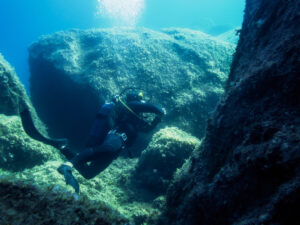What is Ascent Rate?
Ascent rate, a crucial aspect of scuba diving, refers to the speed at which a diver rises to the surface after a dive. It is essential to adhere to recommended ascent rates to minimize the risk of decompression sickness, a potentially life-threatening condition that can result from the formation of gas bubbles in the body tissues. This encyclopedia entry will explore the significance of the ascent rate in scuba diving, the recommended rates, potential risks associated with exceeding these rates, and tips for maintaining a safe ascent.
Ascent Rate: Definition and Importance
The ascent rate is the speed at which a scuba diver reduces depth during the final stages of a dive, measured in feet or meters per minute. It is an essential component of dive planning and execution, ensuring a safe and controlled return to the surface. By maintaining an appropriate ascent rate, divers can avoid rapid pressure changes in the body, which can lead to decompression sickness, barotrauma, and other diving-related injuries.
Recommended Ascent Rates
Dive organizations, such as the Professional Association of Diving Instructors (PADI) and the National Association of Underwater Instructors (NAUI), recommend an ascent rate of no more than 30 feet (9 meters) per minute. This rate allows the diver’s body to safely release dissolved gases, primarily nitrogen, from tissues and bloodstream through respiration, preventing bubble formation.
Some organizations, such as the British Sub-Aqua Club (BSAC), suggest an even more conservative ascent rate of 15 to 20 feet (4.5 to 6 meters) per minute. In addition to adhering to a specific ascent rate, divers are often advised to perform a safety stop—a pause at a depth of 15 to 20 feet (4.5 to 6 meters) for three to five minutes—towards the end of the ascent, which further reduces the risk of decompression sickness.
Risks of Exceeding the Recommended Ascent Rate
Decompression Sickness (DCS)
Exceeding the recommended ascent rate can increase the likelihood of decompression sickness, a condition caused by nitrogen bubbles forming in the body’s tissues and bloodstream. DCS symptoms can range from mild joint pain and skin rashes to severe neurological issues, paralysis, and even death.
Barotrauma
Rapid ascents can lead to barotrauma, or pressure-related injuries, affecting various parts of the body, including the ears, sinuses, lungs, and teeth. Barotrauma can cause pain, discomfort, and in severe cases, permanent damage or even death.
Pulmonary Over-Pressurization Syndrome (POPS)
If a diver holds their breath while ascending rapidly, the expanding air in the lungs can cause the lung tissues to rupture, leading to POPS. Symptoms include chest pain, shortness of breath, and coughing up blood. This condition can be fatal if not treated promptly.
Maintaining a Safe Ascent Rate
Dive Computer
Dive computers are essential tools for monitoring ascent rates, as they continuously track depth and time during a dive. They provide real-time feedback, alerting divers if they are ascending too quickly and allowing them to adjust their speed accordingly.
Buoyancy Control
Practicing proper buoyancy control throughout a dive can help maintain a consistent and controlled ascent. By mastering the use of the buoyancy control device (BCD) and understanding the effects of depth and pressure on buoyancy, divers can prevent rapid ascents and descent rate fluctuations.
Breathing Techniques
Breathing steadily and continuously throughout the ascent is crucial to avoid complications like POPS. Avoid holding your breath and focus on exhaling fully during the ascent to allow expanding air to escape from the lungs.
Gradual Ascent
Adopting a gradual and controlled ascent strategy, rather than a rapid one, can help divers maintain a safe ascent rate. By ascending in stages and pausing at regular intervals, divers can better manage their buoyancy, monitor their ascent rate, and reduce the risk of DCS and other diving-related injuries.
Safety Stop
Incorporating a safety stop during the ascent—typically at a depth of 15 to 20 feet (4.5 to 6 meters) for three to five minutes—allows the body additional time to off-gas dissolved nitrogen, further decreasing the risk of decompression sickness. Some diving organizations recommend a deeper safety stop for dives exceeding 100 feet (30 meters) in depth.
Dive Planning
Proper dive planning is essential for managing ascent rates and preventing diving-related injuries. By planning the dive profile, including maximum depth, bottom time, and decompression stops, divers can ensure a safe and controlled ascent to the surface.
Dive Training and Experience
As with all aspects of scuba diving, experience and ongoing education play a significant role in maintaining a safe ascent rate. Divers should continue to refine their skills through practice, advanced courses, and by learning from experienced dive buddies and instructors.
Key Takeaways
The ascent rate in scuba diving is a critical factor for ensuring a safe and enjoyable diving experience. By adhering to the recommended ascent rates, divers can minimize the risk of decompression sickness, barotrauma, and other diving-related injuries. To maintain a safe ascent rate, divers should utilize dive computers, practice buoyancy control, employ proper breathing techniques, plan their dives carefully, and continue their diving education. By following these guidelines, scuba divers can enjoy the underwater world while prioritizing their safety and well-being.

















